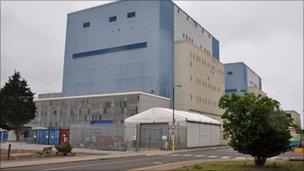Hinkley Point nuclear waste sea disposal plan
- Published

Nuclear waste is currently stored in vaults at Hinkley Point
Plans being developed to deal with nuclear waste at Hinkley Point A in west Somerset will see radioactive gas and liquid released into the sea.
The power station began decommissioning in 2001 and is working on a system to put "intermediate" waste in vats of acid to reduce it down.
Magnox, the company that manages the site, said there would be no risk to public health or the environment.
But a nuclear expert questioned the controls in place at Hinkley Point.
Magnox said the process of dissolving materials in acid would give off gas and produce liquid that was radioactive, however those releases would be very low and cause no harm.
'Nuclear discharges'
The process has been used elsewhere and would not start until at least 2015.
John Large, a nuclear consultant who has worked with power companies and Greenpeace, said: "If you look at the history and the development of the British nuclear industry, and look at the calamity that was caused by radioactive discharges around Sellafield, if the past practice is a sign I don't think sufficient guards and controls will be in place at this station."
Before this process can start, it needs to be approved by the Environment Agency and the Office for Nuclear Regulation, and the company will have to apply for planning permission for a new building.
Colin Patchett, deputy chief inspector at the Office for Nuclear Regulation, said: "Our mission is to protect people and society from hazards of the nuclear industry and it's up to Magnox to prove to us that it is safe to carry out these activities."
Hinkley Point currently has one working nuclear power station and plans by EDF Energy to build another reactor are currently at the consultation stage.
- Published4 May 2011
- Published15 December 2010
- Published19 October 2010